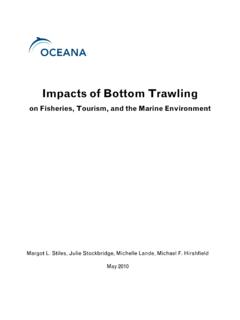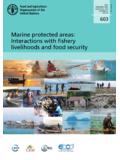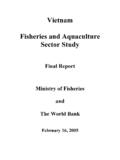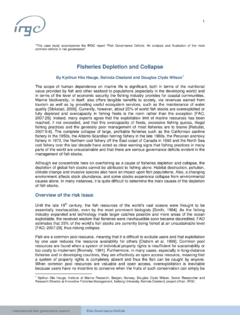Transcription of THE PHILIPPINE FISHERIES CODE OF 1998 (RA No. …
1 IMPLEMENTING RULES AND REGULATIONS THE PHILIPPINE FISHERIES code OF 1998 (RA No. 8550) Department of Agriculture Bureau of FISHERIES and Aquatic Resources Arcadia Building, Quezon Ave., Quezon City 21 May 19982 RA 8550 Implementing Rules and Regulations Republic of the Philippines DEPARTMENT OF AGRICULTURE Office of the Secretary Elliptical Road, Diliman, Quezon City DEPARTMENT OF AGRICULTURE ADMINISTRATIVE ) ORDER NO. 3 : Series of 1998 .. ) IMPLEMENTING RULES AND REGULATIONS Pursuant to Republic Act No. 8550: AN ACT PROVIDING FOR THE DEVELOPMENT, MANAGEMENT AND CONSERVATION OF THE FISHERIES AND AQUATIC RESOURCES, INTEGRATING ALL LAWS PERTINENT THERETO, AND FOR OTHER PURPOSES Sec. 1. Title This Act shall be known as The PHILIPPINE FISHERIES code of 1998 . Rule Title These Rules shall be known and cited as the Implementing Rules and Regulations (IRR) of the PHILIPPINE FISHERIES code of 1998 ; Rule Purpose These Rules are promulgated to prescribe the procedures and guidelines for the implementation of the PHILIPPINE FISHERIES code of 1998 to facilitate compliance therewith and achieve the objectives thereof.
2 CHAPTER I DECLARATION OF POLICY AND DEFINITIONS Sec. 2. Declaration of Policy. It is hereby declared the policy of the State: a. to achieve food security as the overriding consideration in the utilization, management, development, conservation and protection of fishery resources in order to provide the food needs of the population. A flexible policy towards the attainment of food security shall be adopted in response to changes in demographic trends for fish, emerging trends in the trade of fish and other aquatic products in domestic and international markets, and the law of supply and demand; b. to limit access to the fishery and aquatic resources of the Philippines for the exclusive use and enjoyment of Filipino citizens; c. to ensure the rational and sustainable development, management and conservation of the fishery and aquatic resources in PHILIPPINE waters including the Exclusive Economic Zone (EEZ) and in the adjacent high seas, consistent with the primordial objective of maintaining a sound ecological balance, protecting and enhancing the quality of the environment; d.
3 To protect the rights of fisherfolk, especially of the local communities, with priority to municipal fisherfolk, in the preferential use of the municipal waters. Such preferential use shall be based on, but not limited to, Maximum Sustainable Yield (MSY) or Total Allowable Catch (TAC) on the basis of resources and ecological conditions, and shall be consistent with our commitments under international treaties and agreements; e. to provide support to the fishery sector, primarily to the municipal fisherfolk, including women and youth sectors, through appropriate technology and research, adequate financial, production, construction of post-harvest facilities, marketing assistance, and other services. The protection of municipal fisherfolk against foreign intrusion shall extend to offshore fishing grounds. Fishworkers shall receive a just share for their labor in the utilization of marine and fishery resources; RA 8550 Implementing Rules and Regulations 3 f.
4 To manage fishery and aquatic resources, in a manner consistent with the concept of an integrated coastal area management in specific natural fishery management areas, appropriately supported by research, technical services and guidance provided by the State, and g. to grant the private sector the privilege to utilize fishery resources under the basic concept that the grantee, licensee or permittee thereof shall not only be a privileged beneficiary of the State but also an active participant and partner of the government in the sustainable development, management, conservation and protection of the fishery and aquatic resources of the country. The State shall ensure the attainment of the following objectives of the fishery sector: 1. Conservation, protection and sustained management of the country s fishery and aquatic resources; 2. Poverty alleviation and the provision of supplementary livelihood among municipal fisherfolk; 3.
5 Improvement of productivity of aquaculture within ecological limits; 4. Optimal utilization of offshore and deep-sea resources; and 5. Upgrading of post-harvest technology. Application of its Provisions -- The provisions of this code shall be enforced in: a. all PHILIPPINE waters including other waters over which the Philippines has sovereignty and jurisdiction, and the country s 200 nautical mile Exclusive Economic Zone (EEZ) and continental shelf; b. all aquatic and fishery resources whether inland, coastal or offshore fishing areas, including but not limited to fishponds, fish pens/cages; and c. all lands devoted to aquaculture, or businesses and activities relating to fishery, whether private or public lands. Rule Jurisdiction. The Department, through the Bureau of FISHERIES and Aquatic Resources (BFAR), in cooperation with concerned national agencies, shall have the responsibility and jurisdiction in the management, conservation, development, protection, utilization, and disposition of all FISHERIES and aquatic resources of the country, except municipal waters.
6 However, in municipal waters the DA-BFAR may coordinate with and assist the LGUs, FARMCs, and other government agencies concerned in the development, conservation, protection, utilization and management of FISHERIES and aquatic resources. Rule The Department and the Department of Environment and Natural Resources (DENR) shall, within one (1) year from the effectivity of this IRR, issue a Joint Memorandum Order to clarify their respective jurisdiction and authority on the management of FISHERIES resources. Sec. 4. Definition of Terms. As used in this code , the following terms and phrases shall mean as follows: 1. Ancillary industries firms or companies related to the supply, construction and maintenance of fishing vessels, gears, nets and other fishing paraphernalia; fishery machine shops; and other facilities such as hatcheries, nurseries, feed plants, cold storage, and refrigeration, processing plants and other pre-harvest and post-harvest facilities.
7 2. Appropriate fishing technology adaptable technology, both in fishing and ancillary industries, that is ecologically sound, locally source-based and labor-intensive. 3. Aquaculture fishery operations involving all forms of raising and culturing fish and other fishery species in fresh, brackish and marine areas. 4. Aquatic pollution the introduction by human or machine, directly or indirectly, of substances or energy to the aquatic environment, which results or is likely to result in such deleterious effects as to harm living and non-living aquatic resources, pose potential and/or real hazard to human health, hindrance to aquatic activities as fishing and navigation, including dumping/disposal of waste and other marine litters, discharge of petroleum or residual products of petroleum or carbonaceous materials/substances and other radioactive, noxious or harmful liquid, gaseous or solid substances, from any water, land or air transport or other human-made structure.
8 Deforestation, unsound agricultural practices such as the use of banned chemicals and excessive use of chemicals, 4 RA 8550 Implementing Rules and Regulations intensive use of artificial fish feed, and wetland conversion, which similar hazards and deleterious effects shall also constitute aquatic pollution. 5. Aquatic resources includes fish, all other aquatic flora and fauna and other living resources of the aquatic environment, including but not limited to salt and corals; 6. Artificial reefs any structure of natural or man-made materials placed on a body of water to serve as shelter and habitat, source of food, breeding areas for fishery species and shoreline protection; 7. Catch ceilings refer to the annual catch limits allowed to be taken, gathered, or harvested from any fishing area in consideration of the need to prevent overfishing and harmful depletion of breeding stocks of aquatic organisms; 8.
9 Closed season the period during which the taking of specified fishery species by a specified gear is prohibited in a specified area or areas in PHILIPPINE waters; 9. Coastal area/zone is a band of dry land and adjacent ocean space (water and submerged land) in which terrestrial processes and uses directly affect oceanic processes and uses, and vice versa; its geographic extent may include areas within a landmark limit of one (1) kilometer from the shoreline at high tide to include mangrove swamps, brackishwater ponds, nipa swamps, estuarine rivers, sandy beaches and other areas within a seaward limit of 200 meters isobath to include coral reefs, algal flats, seagrass beds, and other soft-bottom areas; 10. Commercial fishing the taking of fishery species by passive or active gear for trade, business or profit beyond subsistence or sports fishing, to be further classified as: 1. Small-scale commercial fishing fishing with passive or active gear utilizing fishing vessels of gross tons (GT) up to twenty (20) GT; 2.
10 Medium-scale commercial fishing fishing utilizing active gears and vessels of GT up to one hundred fifty (150) GT; and 3. Large-scale commercial fishing fishing utilizing active gears and vessels of more than one hundred fifty (150) GT. 11. Commercial scale a scheme of producing a minimum harvest per hectare per year of milkfish or other species including those raised in pens, cages and tanks to be determined by the Department in consultation with the concerned sectors. 12. Coral the hard calcareous substance made up of the skeleton of marine coelenterate polyps which includes reefs, shelves and atolls or any of the marine coelenterate animals living in colonies where their skeletons form a stony mass. They include: (a) skeletons of anthozoan coelenterates characterized as having a rigid axis of compact calcareous or horny spicules, belonging to the genus corallium as represented by the red, pink, and white corals which are considered precious corals; (b) skeletons of anthozoan coelenterates characterized by thorny, horny axis such as antipatharians represented by the black corals which are considered semi-precious corals; and (c) ordinary corals which are any kind of corals that are not precious nor semi-precious.






